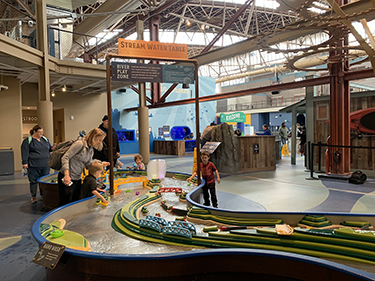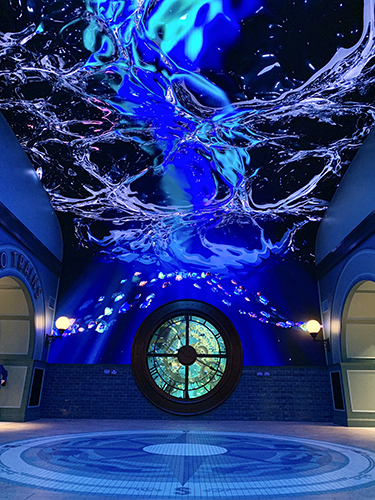|
Subscribe / Renew |
|
|
Contact Us |
|
| ► Subscribe to our Free Weekly Newsletter | |
| home | Welcome, sign in or click here to subscribe. | login |
Environment
| |
 |
April 25, 2024
Making old buildings new again: the case for adaptive reuse
MLA Engineering

Leonard
|
We know that the world is undergoing the largest wave of urban growth in history. As the number of people living in cities increases, so does the need for building inventory —challenging existing infrastructure and available resources. But new construction is not the only solution. Finding a sustainable alternative is an exercise in recognizing an old building’s potential for new life. Structural engineers are in the midst of this creative process, determining the durability and safety of existing buildings and feasibility of retrofits. By extending a structure’s operational life, we are helping to maximize the built environment and its embodied energy through adaptive reuse projects.
Additionally, we want to highlight the role of adaptive reuse in sustaining the unique history and spirit that existing buildings bring to their communities. By giving outdated yet beloved structures new meaning and purpose, we are also strengthening the cultural roots of their environments. When we can preserve a building’s architectural aesthetics while making it more functionally relevant, we are also contributing to a sense of place that endures.
CHALLENGING THE ONE-GENERATION BUILDING
The days of one-generation buildings are falling into the past. Structural engineers know good bones when we see them which, among other factors, is critical to making adaptive reuse economically feasible. Extending the life of a structure also plays into tight budgets and site availability.
A building still has a serviceable life when it meets the intended functional needs and can be operated within the typical annual maintenance costs. We also look for an economic, environmental, zoning, and historical benefit to keep significant portions of the building in place, with only minor repairs or upgrades required to meet its repurposed function.
The evaluation process is critical in the early stages of the project to estimate the building’s remaining life. Depending on the environmental loads, this phase typically includes a seismic evaluation and materials testing to determine durability and the extent of deterioration. Discussions also include architectural modifications, updates to finishes, and MEP retrofit to assess the resulting construction cost.
SETTING THE COURSE FOR TRANSFORMATION
There are many items to consider when determining if adaptive re-use makes sense. Although the structural frame and foundation are fundamental to a cost-effective reuse, all disciplines need to be considered and coordinated during the project’s feasibility phase. Structural engineers innovate as design opportunities present themselves and enjoy collaborating with project owners and designers to generate ideas and then evaluate the merits and costs of each one.
Diving deeper, our knowledge of load-bearing and seismic resilience issues combined with what goes on inside the walls is necessary to itemize potential costs that will impact the total project budget. We avoid retrofitting too much by identifying where we can leave costly features alone, which elements we recommend for further testing, and how we can give the client a reasonable range of options, costs, and benefits they can use for confident decision-making.
EXPLORING POTENTIAL
Sometimes, only a portion of an aging structure is selected for remodeling. This was the case when we were enlisted to help launch another iteration of Tacoma’s Freight-house Square. The 1920s building, originally designed as a warehouse for materials being loaded onto freight trains, is a timber post and beam structure. Additions over the following 20 years expanded the building eastward. MLA’s assessment and evaluation focused on the structural issues and extent of construction associated with reusing parts of the existing wood-framed superstructure and concrete foundations to reconfigure the building as an Amtrak station.
The first task was for us to identify seismic vulnerabilities and complete a concept plan for the required seismic upgrades. Based on our findings, we were able to explore the possibilities for development and make economic comparisons for preservation versus new construction. MLA’s final role was to design the concrete platform, soldier pile retaining wall, MSE ramp wall, and steel canopy structures. We found ourselves meeting many unique challenges that included coordinating with multiple transit agencies related to the adjacent Sound Transit construction project. Throughout the process, structural engineering insights on the pros and cons of different solutions helped our client determine the most effective and efficient approach to adaptive reuse.
RENEWING A COMMUNITY LANDMARK
Adaptive reuse projects can be impressively creative and even visionary to bring new life and meaning to a beloved community landmark. MLA provided structural engineering for the first aquarium in St. Louis, Mo. as part of a major renovation of the city’s historic Union Station—the world’s largest and busiest train station when it opened in 1892.
The project had its challenges, as it needed to be constructed inside the original train shed. While the two-story, 120,000-square-foot complex includes nearly one million gallons of new water exhibits, the aquarium had to be kept structurally independent from the existing building to avoid extensive retrofit of the historic superstructure. Due to the deep, unsuitable soils, the entire project was installed on approximately 80-foot-deep micro-piles that required coordination to support the new structure while avoiding existing wood piles and foundations. Using Revit to model all the structural, architectural, and life support system elements, in combination with several intense collaboration sessions, proved necessary and valuable to design a suitable foundation system within the limited space available.
FULFILLING A COMMUNITY NEED
As communities evolve, places constructed for a particular use regularly lose their relevance. Vacant office buildings are a prime example. Recently, four such existing structures in Seattle, Kirkland, Renton, and Enumclaw were given new purpose by being converted into dialysis centers for Kidney Centers Northwest. More importantly, these projects demonstrate how adaptive reuse, as a cost effective model, is especially relevant for non-profit budgets designed to fulfill essential public needs.
Known for being the world’s first outpatient dialysis organization, Kidney Centers Northwest now treats thousand of citizens each year whose lives depend on visiting several times each week. With the objective to improve accessiblity by spreading as many facilities as possible throughout the region and keep treatments affordable, adaptive reuse became the obvious cost-effective strategy.
Our efforts in Enumclaw were the most notable, beginning with seismic evaluation of an an 8,765-square-foot structure that continued with strategic upgrades, including additional underfloor framing for increased floor loading, new openings in brick CMU walls, equipment bracing, and floor framing for scale depression. We also reviewed the existing roofing trusses and worked extensively with the mechanical engineer to limit the extra roof framing required for new mechanical units.
CHANGING A BUILDING’S FUNCTIONALITY
Inserting new activities into an existing building and updating systems to become code compliant takes place within a complex matrix of design factors. When visitors to KidsQuest Children’s Museum far exceeded the capacity of its original mall space in Factoria, the decision was made to double in size by renovating a former doll museum in downtown Bellevue. Updating the project’s original purpose for a new era required transforming the existing 13,500 square feet into nine interactive zones for learning through play.
MLA was responsible for the project’s structural design, extensive renovation and seismic retrofit. Our efforts included removing or reconfiguring portions of bearing and shear walls, enlarging the north central portion of the main floor to create a small addition and to extend the on-grade space northward.
The significant area of renovations and modifications to the lateral resisting structure triggered substantial alteration provisions in the International Existing Building Code, with the most extensive of the requirements being for increased floor loading and seismic performance. New openings for doors and windows, upgrades to shear walls, and strengthening of floor elements were all essential to support the new exhibits and change in occupancy. Installation of the two-story climbing frame and a full-size semi-truck cab in particular required creative structural planning and coordination.
DEVISING NEW MATERIALS
Looking for space to house a new linear accelerator, Group Health in Seattle’s Capitol Hill neighborhood turned to an existing basement room located underneath a parking and loading area for busses. With only two feet available overhead, the key was to provide adequate radiation shielding—typically provided by a three-foot thick concrete mass. The solution that best met the competing requirements was to remove and replace a portion of the existing drop-panel slab and replace it with a specialized high-density steel-aggregate concrete slab along with sheets of steel plate that provided the radiation shielding required. A high-strength concrete wall replaced one of the original columns that supports the slab.
SUPPORTING SUSTAINABLE COMMUNITIES
Among the various types of green building projects, adaptive reuse makes special sense from the standpoint of embodied energy. We typically understand this to mean the decades required for a new building to overcome the climate change impacts created by its construction. At the same time, embodied energy could be seen from the perspective of a structure’s meaning to its community. Adaptive reuse has improved in creativity and ability to integrate a community’s sense of identity and place with the renovated building. By redeveloping an existing building’s functional relevance, we are also connecting its past with the future — incorporating the initial investment to strengthen and enrich its new purpose going forward.
Michael Leonard is the principal and owner of MLA Engineering.
Other Stories:
- Creativity and innovation are hallmarks of sustainability at PDX Airport
- Curbing construction’s carbon impact from all angles
- Promoting residential adaptive reuse in Seattle through policy
- Hiding in Plain Sight: Sustainability and resilience beyond the terminal
- Reducing embodied carbon in concrete construction
- A blueprint for environmental responsibility in construction
- Old building, new tricks: Designing adaptive reuse for long-lasting relevance
- Harnessing the potential of mixed-use communities
- Implementing aggressive water goals
- Toward a path to zero carbon: building renovations and circular economy principles
- A primer on campus decarbonization in Washington




